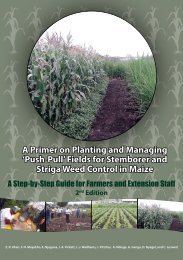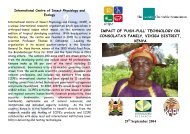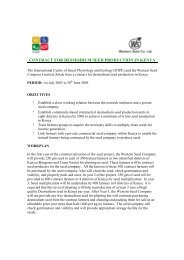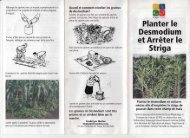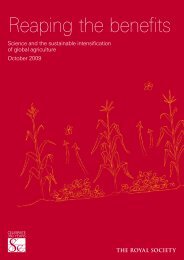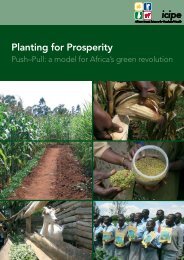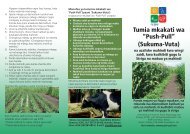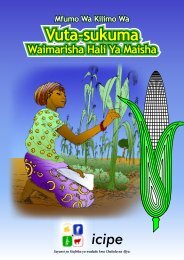Biology and management of economically important ... - Push-Pull
Biology and management of economically important ... - Push-Pull
Biology and management of economically important ... - Push-Pull
You also want an ePaper? Increase the reach of your titles
YUMPU automatically turns print PDFs into web optimized ePapers that Google loves.
712 KFIR ET AL.<br />
larvae enter the stem, the plant produces a gummy substance that causes the death<br />
<strong>of</strong> the pest (76). In on-farm trials in Kenya, planting Napier grass around maize<br />
fields significantly increases crop yields by reducing the stem borer population in<br />
maize. Sudan grass, also a fodder grass, provided natural control <strong>of</strong> stem borers<br />
by acting as a trap plant <strong>and</strong> as a reservoir for its natural enemies (99). In field<br />
trials conducted in Kenya, planting Sudan grass around maize fields decreased<br />
stem borer infestation on maize <strong>and</strong> thus increased crop yield (99). Planting Sudan<br />
grass around maize field also increased efficiency <strong>of</strong> natural enemies.<br />
For the control <strong>of</strong> stem borers in resource-poor, maize farming systems in<br />
eastern Africa, novel habitat-<strong>management</strong> strategies have been developed using<br />
“push-pull” or stimulo-deterrent diversionary tactics (100). These strategies involve<br />
combined use <strong>of</strong> intercropping <strong>and</strong> trap crop systems. Stem borers are trapped<br />
on highly susceptible trap plants (pull) <strong>and</strong> are driven away from the maize crop by<br />
repellent intercrops (push). The plants, which are used as trap or repellent plants in<br />
a push-pull strategy, are Napier grass, Sudan grass, molasses grass, <strong>and</strong> silverleaf<br />
desmodium, Desmodium uncinatum. Napier grass <strong>and</strong> Sudan grass are used as<br />
trap plants, whereas molasses grass <strong>and</strong> silverleaf desmodium repel ovipositing<br />
stem borers. Molasses grass, when intercropped with maize, not only reduced infestation<br />
<strong>of</strong> the maize by stem borers but also increased stem borer parasitism by<br />
a natural enemy, C. sesamiae (98). All four plants are <strong>of</strong> economic importance to<br />
farmers in eastern Africa as livestock fodder.<br />
The economic gain from the use <strong>of</strong> intercrops depends on the balance between<br />
a lowered cost <strong>of</strong> control <strong>of</strong> stem borers <strong>and</strong> the increased cost <strong>of</strong> maintaining an<br />
intercropped field, along with any decrease in yield <strong>of</strong> the main crop from greater<br />
plant competition. Net pr<strong>of</strong>it can be increased if the intercrop favorably changes the<br />
balance between income <strong>and</strong> costs. Economic data assessing the financial returns<br />
as well as the biological effects are therefore most useful in making decisions on<br />
the use <strong>of</strong> intercrops <strong>and</strong> trap plants for stem borer control.<br />
Management <strong>of</strong> Crop Residues<br />
Crop residues are <strong>important</strong> for carrying over stem borer larval populations from<br />
one growing season to the next. In Nigeria, larvae <strong>of</strong> B. fusca, E. saccharina,<br />
<strong>and</strong> S. calamistis were found in crop residues below the soil surface, <strong>and</strong> higher<br />
incidences <strong>of</strong> these borers were observed in no-tillage plots (82). In Kenya,<br />
C. orichalcociliellus, C. partellus, E. saccharina, <strong>and</strong> S. calamistis were observed<br />
in stalks after harvest (163, 217). In Ethiopia, a considerable proportion <strong>of</strong> B. fusca<br />
larvae survive in stubble (223). In Ug<strong>and</strong>a, untreated crop residues were <strong>of</strong>ten used<br />
to mulch the next crop (115). Under these conditions, borers from the old stalks<br />
constantly infested the newly planted crops.<br />
An effective control option would be to reduce the first generation <strong>of</strong> adult<br />
population by destroying the larvae in old stalks (78, 84, 97, 192). Ploughing in<br />
order to bury maize stubble was an effective control measure used early in the<br />
twentieth century in South Africa to control B. fusca (106). In Zimbabwe, it was



